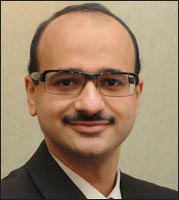Killol Pandya, Head- Fixed Income at Daiwa Asset Management explains what debt products you should recommend your investors in the current interest rate scenario
 We have seen folios of debt schemes increasing. Will we continue to see the interest building up in debt schemes given the continuing uncertainty surrounding the equity markets?
We have seen folios of debt schemes increasing. Will we continue to see the interest building up in debt schemes given the continuing uncertainty surrounding the equity markets?
Equity funds have seen a reduction in folios because equity markets have underperformed significantly. Global factors have led to a downturn in the market. Mutual funds are significant players in the market but we are not as strong as FIIs. Thus the retail interest has gone down. We have seen a period of sustained tightening of interest rates which has made debt funds attractive. Banks were urged to pass on this to customers by hiking deposit rates and lending rates.
Going ahead, interest rates are unlikely to harden further. We are nearing the end of the tightening cycle. We will undergo a period of stability in interest rates and then interest rates will soften. There will be a second bout of interest in debt markets as returns go double digit and investors book capital gains. Once the rates soften, the interest in debt markets will also wane.
Equity markets will not outperform anytime soon because the international crisis is unlikely to go away in a hurry and our economy is also slowing. The interest in debt markets will continue for a couple of quarters after which it will start waning.
What kind of schemes would you recommend now for investors?
Given the current scenario timing the peak of interest rate regime is an upheaval task for retail investors. It is not a good idea to pull out your money and put it in fixed deposits. The bulk of investments have to be in short term schemes. If investors don’t need money till the next quarter then FMPs are the next best option. Investors should take advantage of short and medium term bond funds and dynamic bond funds.
An ideal product to ride the interest rate transition is dynamic bond fund. Dynamic bond funds are created to ride the curve. It is built on the premise that you cannot time the market. Similar is the case with short term and medium term bond funds. A dynamic bond fund allows fund managers to shift allocation where the opportunity exists.
The returns of dynamic bond funds are not superior to bond funds. Why they have not been able to perform when they have a greater flexibility to invest compared to bond funds?
Every fund manager manages a fund in a peculiar manner. It may happen that some fund managers are not able to peg the market correctly. Plain vanilla bond funds are volatile in the short term. Dynamic bond funds remain conservatively placed until the fund manager gets a signal. Aggressive funds will give more extreme performance. You will find that when the interest rates are hiked above market expectation, bond funds perform much worse than dynamic bond funds. A bond fund is a long term fund. It is supposed to be aggressive. It caters to high risk appetite investors. Bond funds invariably outperform dynamic bond funds in the event of positive news in the market. But if you look at the long term performance the difference is not much between both funds. The wild card is the fund manager.
So shouldn’t investors invest in plain vanilla bond funds instead of dynamic bond fund?
Different products serve different needs. All investors do not exhibit the same tendency. Investors with six months to one year time horizon and willing to take short term pain for long term gain could invest in bond funds. Investors should allocate their investments as per their risk appetite. Dynamic bond funds serve those investors who can’t track interest rates. Dynamic bond fund investors don’t take any interest rate call.
What are your expectations from RBI’s next policy meeting?
The next policy meet is going to be a non-event. I don’t expect any rate action this time. There have been contradictory reports relating to CRR in media. RBI’s stance will change if inflation comes down and that has not happened yet. If CRR is cut market participants will get confused whether the softening cycle has started or not. CRR is just a signaling rate and not a monetary stance. It is not a liquidity management tool. RBI will only use CRR if it is forced to do so. An open market operation (OMO) is another powerful option with RBI and it’s not been used in any great degree. Its capacity is huge. RBI can do OMO of at least Rs. 60,000 to Rs. 70,000 crore. CRR can be tweaked if OMO is not effective. I am not convinced that RBI will bring CRR cut anytime soon. RBI had told us that the chances of rate hike in December are low. The GDP and IIP number are showing signs of the broader economy slowing down which should translate into reduction of WPI which is the ultimate aim of RBI. If that happens then there is no need for further rate hikes.
We have seen the rupee depreciating consistently. How is it impacting debt markets?
Rupee movements have an indirect impact on the debt markets. Rupee dictates what RBI does. If rupee depreciates steeply, then it is RBI’s job to stabilize the currency. Debt funds have to sell dollars to suck out rupee. So it exacerbates liquidity tightness. If RBI intervenes liquidity will be sucked out then it is a negative sign for markets. There are other ways to manage it. RBI has increased FII investment limit to $ 10 billion in Indian debt market which is more than the FII outflow. This money will flow in the Indian markets in the next 45 to 90 days. Rupee is depreciating because FIIs are moving out of India. RBI had to fund $5 billion of outflows. The limits were auctioned on November 30 and the entire $10 billion was subscribed by FIIs. So now they are committed to bring in that money. A depreciating rupee leads to hardening of yields.
RBI deregulated savings rate. Is it proving to be a concern for liquid funds?
Not all banks are offering 6%. Liquid funds and savings bank cater to different investor needs. Liquid funds were never tailor made for retail investors. They were made for institutions. The savings bank option is not open to these entities. They have to park in current accounts which don’t offer any interest. The banking industry’s average interest on savings account is close to 4%. Let’s assume that all banks are offering 6%. The industry average return on liquid fund is 9%. So there is a distinct arbitrage. Another option for retail investors is bank FD. Some bank may give them 9% but they lose out on the liquidity front. Bank FD has to be for a minimum seven days. The USP of liquid fund is liquidity. The arbitrage has not narrowed fully.
You currently do not have any capital protection funds. Are you looking to launch capital protection funds? Do you plan to launch gold funds or ETFs?
We are looking at these products. We entered this industry recently only. The period since our entry has been marked by distinct underperformance of equity markets. On the other hand debt funds are giving good returns. That is why we have launched more debt funds than equity funds. We are looking to launch a dynamic gilt and dynamic bond fund in the immediate future. We are looking to do some innovation in debt funds.
We are seeing a lot of FMPs being launched. Given the thin margins how much does an AMC need to collect from a FMP in order to earn some profit?
Not all schemes can be profitable all the time. Nobody expects to collect a huge amount from a three month FMP. Most of the expenses incurred on FMPs are on the operation side. At least Rs. 30 crore needs to be raised. It caters mainly to institutions and semi institutional clients.
Not many distributors are active in selling debt funds. What would be your advice to them?
There is a need for increased interaction between the fund houses and distributors. Equity funds have remained their main source of income. The retail model on debt funds has not been explored by the industry. Unfortunately a large number of investors equate debt with bank fixed deposits. We have to create a mind space. There are debt funds which serve retail investors needs. We just need to go and tell them. Debt funds ought to be a part of every investor’s portfolio.




